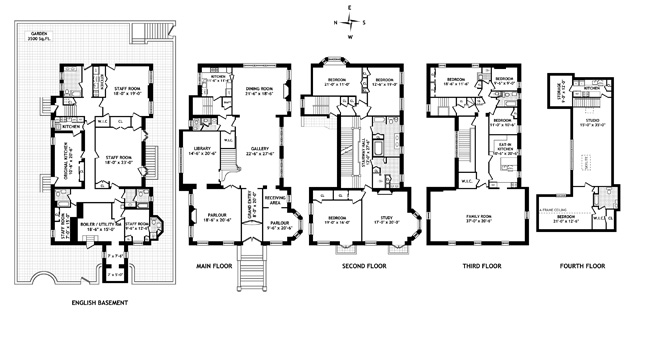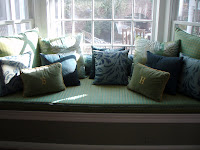After my "
Design Way Out of Reach" post, I wanted to prove that you don't have to pay DWR prices to get great design. But finding useful and good-looking furnishings under the arbitrary cutoff of $100 turned out to be surprisingly difficult. If you looked solely at furniture there turned out to be very little available under $100, if you looked at lighting there turned out to be very few interesting pieces, and if you looked at the wide range of "decorative accents," vases, frames, and so on, there turned out to be way to much to wade through. But here it is anyway, a first stab at finding some great design under $100.


These are familiar faces. Karin has a couple of Stefan chairs (Ikea $19.99 each) in her room in this warm red tone. They are incredibly sturdy, surprisingly comfortable, and double as side tables. The Helmer drawer unit, also from Ikea ($39.99), is also a feature of Karin's room. Ikea used to have a version with wooden drawers that I bought a while ago and use as my bedside table. The drawers are a perfect size, big enough for magazines, small enough that things don't get lost in them, and having so many lets you organize your stuff. I have a drawer for jewelery, another for stationary, etc.


Most of the items I found have a clear modernist aesthetic, but these are some more traditional pieces. The Ingolf chair (Ikea $69.99) is reminiscent of the X-back Klismos chair I discussed in "
DC's Design Open House." It comes straight of the Swedish
Gustavian tradition, so I would give it a coat of distressed white paint. The metal side table is from Target ($49.99) and copies
Directoir-style end tables from the Napoleonic era onwards (which are examples of campaign furniture, also discussed in "DC's Design Open House"). The table's details are clearly not as fine as more expensive options from places like
Restoration Hardware, but it gives a very stylish bang for its buck.


Stools are wonderful things to have around, especially if they also double as tables, like both of these do. Two of the Benjamin stools (left, Ikea $19.99 each) could sit flush to form a coffee table or be stacked out of the way when not in use. The tapered three-leg stools from West Elm ($89-$99) are actually marketed as side tables already, but they would clearly do for extra seating in a pinch.


I struggled to find a nice dining table for under $100 before discovering this piece at Target ($49.99). It's a wooden folding table, which these days is surprisingly hard to find, so it doesn't look half-bad without a table cloth. That makes it just as good for a card game as for a dinner party. I am a huge fan of nesting tables, such as these Klubbo tables from Ikea ($59.99 for the set). They can be strung together as pictured to form a coffee table, or separated to be used as end tables throughout a room, or nested together to create more room.

It's hard to say exactly which chair these scoop back chairs from West Elm ($79) are modelled after, because there are so many modern plastic-shell chairs with those curvy lines. Yet its that vagueness that makes them successful, if they tried to hard to copy a particularly famous piece, they'd probably just look cheap.



Minor details on these lamps put them a cut above the competition. The Kane floor lamp ($79.95) from CB2, Crate and Barrel's inexpensive arm, has a base that echos the Tulip Collection of Eero Saarinen (discussed in "
Design Way Out of Reach"). The Swing Arm table lamp (West Elm $89-$99) creates practical task lighting but gives the familiar lamp design a fresh look with strict modern lines and a shiny chrome finish. The Dots Pendant Lamp (West Elm $89) similarly updates a classic design with a unique twist, circular cutouts that let it shine.

My favorite design buy under $100 might just be this Lack shelf from Ikea ($69.99), which has no lack (excuse the pun) of practical possible uses. It can stand upright as shown, with the architectural weight of a column, or be mounted horizontally on a wall, where it would look especially good above a sideboard, sofa, or bed. If you hung it at the proper height it could actually be a sideboard, with open storage for serving pieces. You could rest it horizontally on the floor and use it to store a flat-screen TV with media equipment below. You could mount casters or legs underneath and turn it into a storage bench. So simple, so ingenious.
Do you have an example of great design under $100? Post a comment or send an email to katharine.wells@gmail.com
 Of course this cup wouldn't fool the eye so convincingly if the person drinking from it wasn't a white woman, but I still love the idea. People are surprsingly vulnerable when they're taking a sip, and this cup seems to expose that just as it seems to expose a nose and upper lip.
Of course this cup wouldn't fool the eye so convincingly if the person drinking from it wasn't a white woman, but I still love the idea. People are surprsingly vulnerable when they're taking a sip, and this cup seems to expose that just as it seems to expose a nose and upper lip. Again, this bag wouldn't create such a convincing illusion in any other photograph, but what an illusion! This plays into our voyeuristic and exhibitionist fantasies. In fact, I'm not sure whose having more fun, the person viewing the bag or the woman carrying it.
Again, this bag wouldn't create such a convincing illusion in any other photograph, but what an illusion! This plays into our voyeuristic and exhibitionist fantasies. In fact, I'm not sure whose having more fun, the person viewing the bag or the woman carrying it. These bags combine realist images of people with actual rope to create a striking illusion, but the best part is how they take advantage of a bag's own essential construction.
These bags combine realist images of people with actual rope to create a striking illusion, but the best part is how they take advantage of a bag's own essential construction.































































